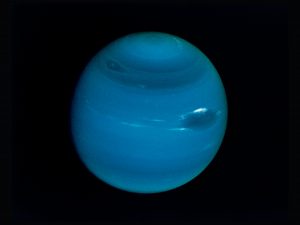Scientists are constantly learning about the other planets in our solar system. It’s not something that many people think about, but other planets have weather phenomena that’s just as dramatic and diverse as ours, if not more! Recently, researchers just made a perplexing discovery about Neptune’s climate; one which is shrouded in mystery.
According to a study published in Planetary Science Journal, after analyzing over 100 infrared images of the planet Neptune, a team of researchers, including scientists from NASA’s Jet Propulsion Laboratory, discovered Neptune’s stratosphere has cooled roughly 8 degrees Celsius (fourteen degrees Fahrenheit) between 2003 and 2018 (ScienceDaily).

The researchers used data from NASA’s Spitzer Space Telescope, the Subaru Telescope, the Keck Telescope, the Gemini South and North telescopes, and the European Southern Observatory’s Very Large Telescope , collected over a 17 year period. Since Neptune is a great distance from Earth, observing its temperatures has only been possible for the past two decades or so, ever since large telescopes like these became available to scientists (Sci-News).
Since 2005, the planet has been in its southern summer season which lasts approximately 40 years. Because it is experiencing its summer season, scientists expected temperatures to have been gradually warming instead of cooling, making the results of the study especially eye-opening. Between 2018 and 2020, scientists were also surprised to find that Neptune’s south pole had risen 11 degrees Celsius. This is the first time that polar warming of this rate has been observed on the planet (ScienceDaily).
Due to how sudden and unexpected the observations were, the cause for these changes are unknown, although the researchers involved in the study have several theories. “Temperature variations may be related to seasonal changes in Neptune’s atmospheric chemistry,” said Dr. Michael Roman, the lead author on the paper, “but random variability in weather patterns or even a response to the 11-year solar activity cycle may also have an effect” (ScienceDaily).
Scientists hope that further observation of Neptune from the James Webb Space Telescope in the coming months may provide an explanation as to the baffling temperature fluctuations. The James Webb Space Telescope’s advanced mid-infrared instrument, MIRI, will allow scientists to more clearly understand the chemistry of Neptune’s atmosphere. Mapping this and the temperatures through the telescope will help to figure out why these changes have been happening on the ice giant (ScienceDaily).
GIANTCLIMES, the project which this study was funded by, was previously involved in studying the atmospheric temperatures of the gas giants Jupiter, Saturn, and ice giant Uranus. GIANTCLIMES has three main objectives: to study and record climate cycles on giant planets, analyze the stratospheres of Saturn and Jupiter over long periods, and to study the ice giants. With the James Webb Space Telescope, GIANTCLIMES hopes to create the first spatial maps of the ice giants (Cordis).
These discoveries have thoroughly challenged the current understanding scientists have of Neptune’s atmospheric variability and go to show how much is still unknown about the planets right here in our own solar system. We have only scratched the surface in researching these distant planets, and over the coming years, a treasure trove of information is sure to be uncovered by teams of scientists like the ones that discovered the temperature fluctuations.
Written by: Matthew Jenkins
Date: May 15, 2022
Sources:
Neptune is cooler than we thought: Study reveals unexpected changes in atmospheric temperatures. (2022, April 11). ScienceDaily. Retrieved from https://www.sciencedaily.com/releases/2022/04/220411101321.htm.
Neptune is Cooler than Astronomers Thought | Sci-News.com. (2022, April 11). Breaking Science News | Sci-News.Com. http://www.sci-news.com/astronomy/cooler-neptune-10697.html
CORDIS | European Commission. (2021, March). European Commission. https://cordis.europa.eu/project/id/723890

